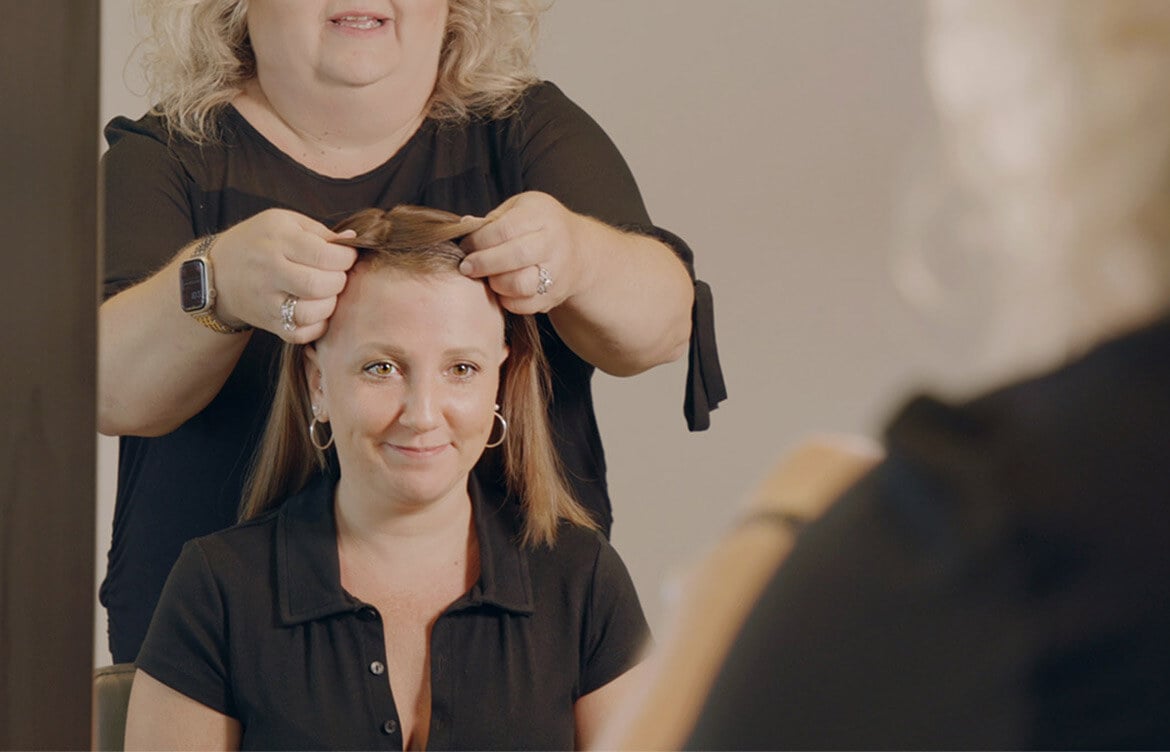Some Misconceptions About Wearing a Wig

If you’re feeling nervous to wear a wig, have you ever stopped to wonder why?
Why might it be embarrassing to wear a wig when we happily apply mascara to our lashes to make them seem longer and fuller without a second thought?
Why do we accept celebrities switching between hair styles, lengths, and colors from one day to the next with no pretense of it being their own hair? And yet we judge every tiny detail about our own appearance, especially when going through hair loss.
We’re going to take a closer look at some of the misconceptions about wearing a wig and, more importantly, some of the realities of wearing a wig in daily life.
Here at Daniel Alain, we think it’s time to put some of the misconceptions about wig-wearing to bed once and for all. But in talking with our customers, we recognise there’s a certain stigma about wigs and we want to address it. We know it’s a hurdle for many people to overcome, but we’ve been in the human hair wig business for many decades, and we see our customers' lives transformed by finding the right wig that makes them feel like themselves again.
There should be no shame in that.
Misconception #1: Wigs Look Fake

Wearing a wig is not quite as old as time - but almost.
The history of wig-wearing stretches back to ancient times when Greeks and Romans wore wigs as fashion statements to denote status. Fast forward to 17th and 18th century Europe when aristocrats and royals were wearing wigs to cover hair loss and as a symbol of wealth. The more elaborate and eccentric the wig, the higher the standing of the wig-wearer.
At the same time, the first settlers to America, particularly those coming from Europe, brought their wig traditions with them and they continued to be a symbol of wealth, status, and social standing.
In more recent times, people, especially women, wore wigs as fashion accessories to mimic the hairstyles of celebrities of the 1960’s and 70’s. Styles like the ‘beehive’, the ‘bouffant’, or the ‘pixie’, made popular by famous women like Jackie Kennedy and Twiggy, were possible and a somewhat affordable luxury with the introduction of synthetic wigs.
Throughout history, wigs were almost always fake-looking. The exaggerated, seemingly impossible heights achieved by some of the more elaborate wig styles of the past flaunted the wealth and status of the wearer. Wigs were never meant to look natural - that would simply defeat the purpose of wearing one.
It’s only in recent years that wig-wearers have demanded a natural and undetectable look from their wig.
The idea that wigs look fake has been around for centuries, and yes, for most of their existence on earth, wigs have looked fake.
But if you’re after a completely natural-looking, undetectable wig that moves and flows like a real head of hair, there has never been a better time in the history of wigs, to be a wig-wearer.
Sure, some wigs continue to look fake. But we’re willing to bet you’ve waited behind someone in line at a coffee shop, sat next to someone on an airplane, or indeed, watched a movie with a famous actress with great hair, and you never noticed their wig.
If you’re willing to invest the time and energy (and, let’s be honest, the money) into finding the right wig for you, we know that you’ll find a piece that restores your confidence and makes you feel like you again.
Misconception #2: Wigs are Uncomfortable
It’s safe to say that the Romans, Victorians, and first European settlers to America probably had a pretty uncomfortable wig-wearing experience. Even King Louis XIV of France with his handpicked staff of devoted wig-makers would have been relieved to rip off his wig at the end of the day.
Early wigs were made with natural materials including plant fibers, goat hair, and even what’s vaguely referred to as ‘animal hair’ - we’d rather not know what animal(s) were used in the production of these.
These wigs were cumbersome, heavy and uncomfortable. They were hot, itchy, and ill-fitting. English diarist and wig-wearer, Samuel Pepys, once wrote about the insufferable itching caused by a lice infestation in one of his wigs.
Fashionable powdered wigs from 17th and 18th century Europe were infamous for irritating the scalp and eyes. The powder, typically made from starch and scented with lavender or orange flower, even caused respiratory problems in some cases.
Later, synthetic hair made from nylon and plastics were developed in an attempt to reproduce the natural look of human hair. But with more of a focus on style, little attention was paid to the wig-wearing experience and certainly not to comfort. They were stiff, hot, and unbreathable.
Wearing a wig at any point in the past was akin to tottering around on a pair of very high-heel shoes several sizes too small.
Scalp irritations, skin infections, and the general burden of wearing something so hot and heavy on the head made for a miserable wig-wearing experience.
More recent advances in manufacturing and technology have meant that modern wig brands are able to create wigs that are breathable, comfortable, and made from natural materials that are kind to the scalp and skin.
These days, most wig-wearers won’t run into any of the problems of the past. A comfortable and natural-looking wig is absolutely possible, and some might say the bare minimum required of a 21st century wig.
If you’re considering a wig, above all, get measured! Work with a professional who is experienced in fitting wigs, try on various styles for a couple of hours so you can feel how they fit over time, find a brand that offers more sizing options beyond the basic small, medium, and large, and make sure the company has a generous return policy in the event you end up with an uncomfortable wig.

You may not be the King of France with a merry troupe of wig-makers, but there’s no reason you can’t have a more comfortable wig than royalty.
Misconception #3: Wigs Can Fall Off Easily
The fear of a wig falling off in public is almost enough to put you off the idea altogether, isn’t it?
It happens.
King George IV of England got his wig caught on an unforgiving branch while out riding his horse. Frank Sinatra once lost his toupee during a particularly energetic performance. Beyoncé had a close call when her hair extensions got caught in a wind fan during a concert, and we’re pretty certain Dolly Parton has had her fair share of close calls.
It takes great strength of character (and a thick skin) to be able to laugh off such an episode. It’s even better to avoid that happening in the first place.
If we’ve said it once, we’ve said it a thousand times. Getting accurately measured for a wig and trying it out is the only way to ensure it’s going to be secure on your head whether you’re performing for crowds or bounding through the countryside on Mister Ed.
Wig security these days is absolutely possible - we’ve had customers ride on roller coasters, ice skate, ski, pose upside down and back to front in yoga, suffer prying tugs from children’s eager hands, and even one or two skydives (with a helmet, of course).
What a comfort it must be to these people who are out being busy and enjoying life, to not have to let their wig-wearing or their hair loss, hold them back.
We know it can feel tempting to buy a wig quietly and anonymously online, without having to speak to a real person. We get it. It can be embarrassing to share our vulnerabilities. But there’s nothing you can say to a wig consultant about your hair loss that would shock them. We promise!
Still Unsure About Wearing a Wig?

It’s normal to approach a new situation with hesitation and a healthy dose of trepidation. Concerns about whether a wig looks natural, is comfortable, and fits securely are exactly the right concerns to have. They’re what will keep you looking for just the right wig without settling for something less than.
Remember, the most common assumptions made about wigs are actually rooted in the past. Modern day wigs can be all the things you’re looking for.
Now that you know your dreams of a perfect wig are possible, we invite you to read some real stories from real wig-wearers. They’ll give you an idea of the transformative power of the right wig better than examples from the past.
Good luck on your journey!

.jpeg)
